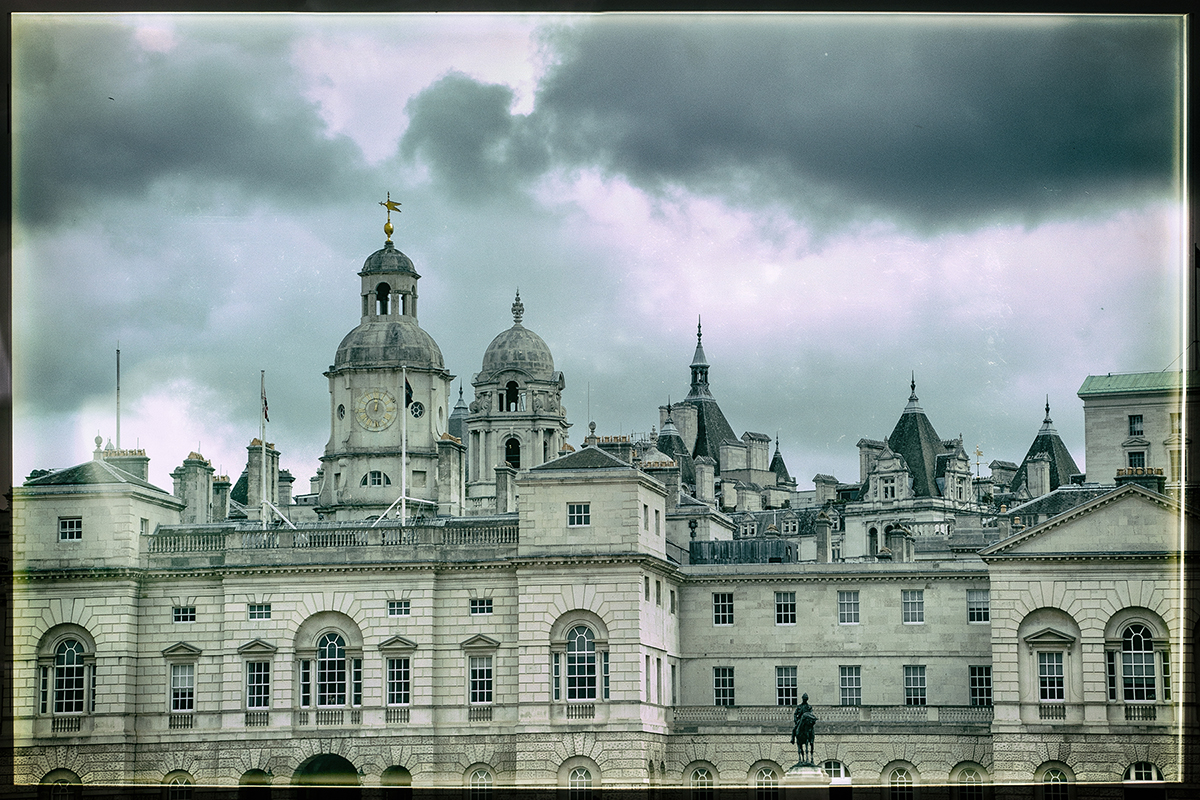Iconic Photography in London and Paris
Kevin Gilligan had a capital time capturing some of the world's most famous sights with his Tamron 16-300mm VC PZD and SP 15-30mm F/2.8 VC lenses.
By Jenn Gidman
Images by Kevin Gilligan
When Kevin Gilligan booked a trip to London and Paris earlier this year, he knew he'd only have a few days in each city—and so he mapped out his photographic goals based on some of the most famous places in both. "Often when I travel, I'm more interested in checking out the remote places and seeing uncommon things," he says. "But it was my first time in both cities, and I'm not really sure when I'll be going back, so I made sure I took in the sights that everyone wants to see."
Kevin wanted to travel light on this trip, so he brought along just two Tamron lenses: the 16-300mm VC PZD and the SP 15-30mm F/2.8 VC. "With these two lenses by my side, it allowed me to capture more expansive scenes in these two destinations, as well as zoom in for some of the more intimate moments and details," he says. His mission: to put his own spin on subjects that have been photographed many times over by plenty of others before him. Here, Kevin's tips for how you can make your own photos of well-traveled cities stand out.
Convert to black and white to show off details.
On our first night in London, we rode the London Eye Ferris wheel as the sun was setting, which was a terrific way to get a view of London and become oriented to the city. It was very dark as we walked back across the Thames, but that's when this photo of Big Ben emerged. I liked the angle I chose to take the photo from, because I was able to get two sides of the structure in the frame.
I had also taken several shots of Big Ben with buses and the bridge in the frame, but I absolutely loved the close-up of the lighting in this shot, as well as the intricate stonework and the gorgeous clock face. Converting to black and white allowed me to draw those details out.
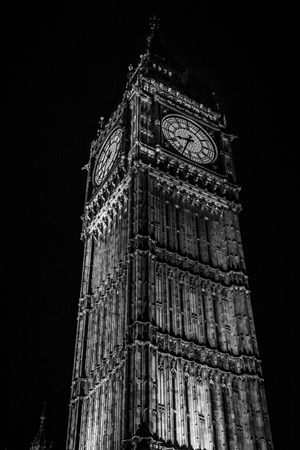
15-30mm (30mm), ISO 1000, F/3.5, 1/30th sec.
Don't shy away from action shots.
The Changing of the Guard outside of Buckingham Palace is one of Britain's most beloved ceremonies—so beloved that it was packed on the Sunday morning we attended, even though we got there a good 40 minutes early. People must have arrived several hours ahead of time (a handy thing to keep in mind if you really want to nab a prime shooting position).
It's a very majestic and ritualized process known all over the world, and I wanted to capture some of that feeling. I was fascinated by the size of the guards' hats and the young guys wearing them, so I wanted to zoom in on that. I also wondered how they were able to see when their hats fell down over their eyes: They're not allowed to make any movements other than the prescribed marching steps, so if those hats slip down, they stay down.
I had to be a little assertive to make my way to the front of the crowd so I could pan along with the guardsmen as they marched by. They really weren't moving that fast, though—I photograph sports like soccer and surfing, and the guards are considerably slower than that. Plus the Vibration Compensation (VC) feature on the 16-300 always helps keep camera shake to a minimum when I'm handholding, as I was here.
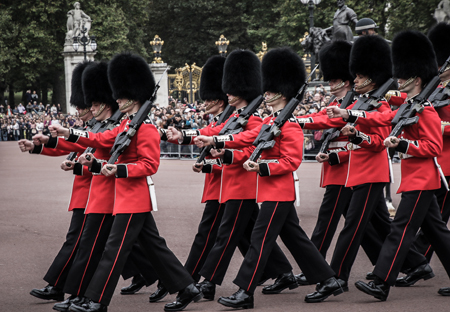
16-300 (92mm), F/8, 1/320th sec.
Capture a facet of your location that shows a defining trait.
London is well known for being overcast, so I wanted to capture that mood if I could. After we left the guard ceremony at the castle, we walked back toward central London and crossed through the queen's garden. While we were standing next to the gardens is when I spotted this scene of the city's skyline, and it perfectly expressed that dark, cloudy London feeling I'd hoped to photograph. All I really had to do with it after I took the picture was a bit of post-processing in Lightroom to bring out more of the clouds and more contrast, then set a frame around it. I'm glad the London weather cooperated with what I wanted to accomplish!
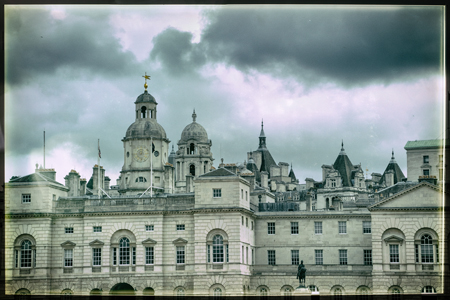
16-300mm (63mm), ISO 200, F/7.1, 1/320th sec.
Be prepared for spontaneous street scenes.
We were taking a stroll along the Thames in an area where there are a lot of cafes and street performers when we stumbled across this tuba player. My wife is a musician, so we make it a habit to always stop and listen to musicians and give money to them. This guy was dressed to the nines and had an old radio that was playing music—with every beat that came out of the radio, he'd blow, and fire would come out of his tuba.
I finally made eye contact with him after about a minute or so of watching his routine and asked if I could take a picture, which he agreed to. Shooting this as a vertical worked well so I could capture his entire body and the flame. Plus, when I'm cropping, I don't like to make it too tight; I wanted there to be a little space in front of his foot and a little space up top, too.
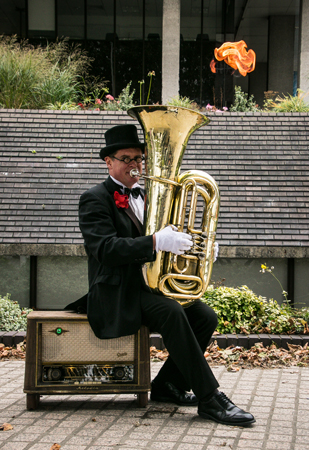
16-300mm (35mm), ISO 1000, F/7.1, 1/320th sec.
Don't give up if the "perfect" scene doesn't immediately emerge.
Moving onto Paris, we were walking near the famous Sacre-Coeur church in the neighborhood of Montmartre one day, and I was a little disappointed that I wasn't finding anything to photograph that didn't seem too touristy. But then something happened that speaks to why it's important to have patience in photography. I put my camera down and looked around, and after a couple of minutes, this picture of an accordion player and a child watching him started unfolding before me. I knew I had to capture this scene. You can see the eye contact and how enraptured the little girl was with the musician.
I also love the people in the background talking at the café; two of the guys are even looking toward me. Showing the names on the restaurant and the art gallery fills viewers in on the fact that I'm in France. I decided to convert the photo to black and white because with the cobblestone streets and the look on the girl's face, it had a timeless feel to it. You can't tell if it was taken in the '50s or yesterday.
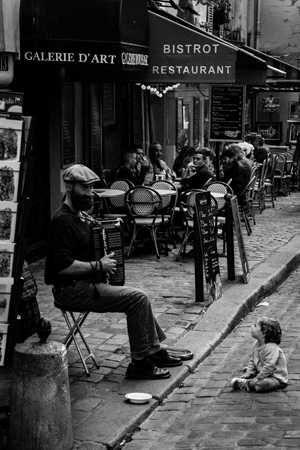
16-300 (48mm), ISO 800, F/6.3, 1/200th sec.
Make pictures of iconic landmarks your own.
It's not a question of if you're going to photograph the Eiffel Tower when you're in Paris, but how you're going to do it. I was hoping to do something a little more unusual than what you typically see. I did a little research and found out the Sacre-Coeur is one of the highest points in the city, so decided that's where I'd go to take my picture.
It's quite a hike to get up there, and the cutoff time was around 7 p.m., but I wanted to wait till the end of the day to take the photo because of the sweet light I knew I'd get then—we made it in by about two minutes before they stopped letting people up. There are these steps people sit on with picnic meals and a glass of wine or beer, and it offers a spectacular view.
Besides the beautiful lighting as the sun went down, I was able to show off some of that intricate latticework in the tower's silhouette. And there were some interesting foreground elements as well. It's hard to take a picture of one of the most photographed landmarks in the world and not make it boring, but I was pretty happy with the way this one came out, and I feel like it's all my own.
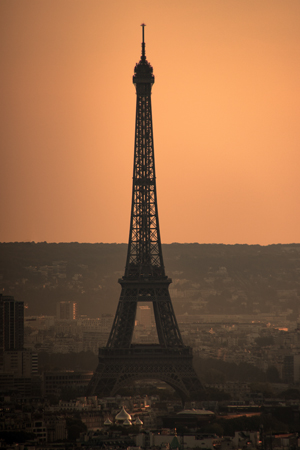
16-300 (300mm), ISO 200, F/7.1, 1/320th sec.
Capture a well-planned portrait.
Before we even crossed the Pond, I knew I wanted a photo of my wife with a few elements incorporated. I live in Southern California, where we don't have a lot of Old World architecture, so that was one requirement. I also wanted to capture a portrait of my wife in a colorful, flowing dress with good lighting. I knew that I was going to try to take this kind of picture at the Louvre—I just wasn't going to know exactly where at the Louvre until we got there.
The day of our visit I took some pictures out front, but it was too busy. Then we found this courtyard in the back. I knew instantly this was the place where I wanted to take the picture. I loved the pattern of the cobblestones, and if you look carefully at the stones, you can see two diagonal lines framing the picture, bringing the viewer's eye toward the middle and also toward the back, where the buildings connect. That helped me decide where I was going to have my wife stand.
We had had a conversation beforehand so she knew what to expect from the shoot (recommended when photographing your own subjects), and she's comfortable with me, obviously, so it didn't take much other than some simple posing. I wanted a little space between her arm and body, and her hips turned toward the camera a certain way to get the image I wanted. This photo shows how you can get a really professional-looking photo with that 16-300 lens.
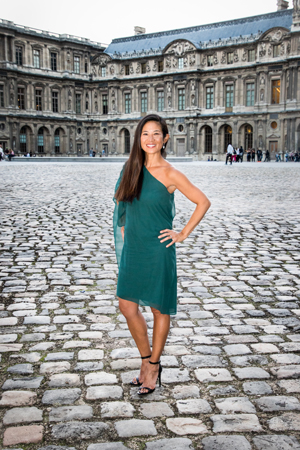
16-300mm (32mm), ISO 1000, F/6.3, 1/60th sec.
Take advantage of the "blue hour."
Right as we finished up that session and the sun went down, a violinist started playing a wonderful Chopin piece and the Louvre flicked on lights that illuminated all of the architecture. It was magical. That's when we moved over and I took the next portrait of the evening.
I'm always thinking about how I can use my surroundings to bring the viewer's eye into the picture. I had also planned out at least one image of my wife in that flowing dress, near similar Old World architecture, but this time in beautiful blue hour lighting. This was my chance; all I had to do was center her directly under the peak of the building to make it visually pleasing. I'm really happy we'll have this shot of her forever. I'd encourage others to think about certain shots they'd like to do before a trip. It's really satisfying to set a goal for yourself and then pull it off.
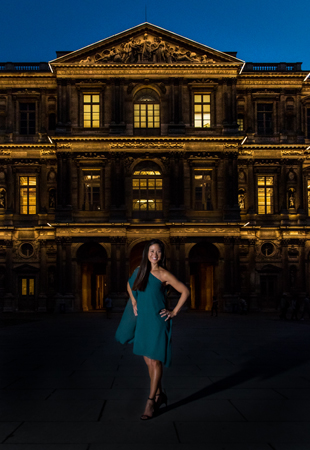
16-300 (16mm), ISO 1600, F/4, 1/40th sec.
Combine Europe's old with the new.
After we did that photo shoot, we sauntered over to the Louvre pyramid, which was lit up and stunning. I took a few shots of the pyramid that didn't blow me away, and then I decided I'd merge the pyramid with that building to the right of it in the frame. I wanted that contrast of the relatively modern architecture of the pyramid with the Old World architecture of the other building.
This was definitely an instance when that 15-30 proved invaluable. I was completely backed up against the far wall in the courtyard, and I utilized every single inch I could to get that wide of a shot. I wouldn't have been able to get everything in if I hadn't had that lens with me. To finish up the image, I simply did a bit of sharpening in Lightroom. I was really happy with the final result.
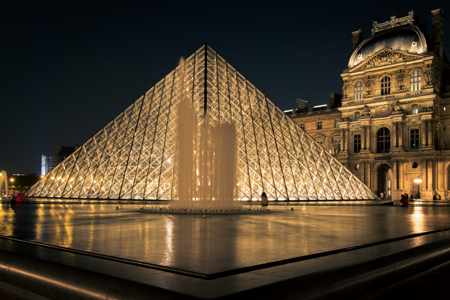
15-30 (15mm), ISO 500, F/7.1, 5 sec.
To see more of Kevin Gilligan's work, go to www.photosbykag.com.
